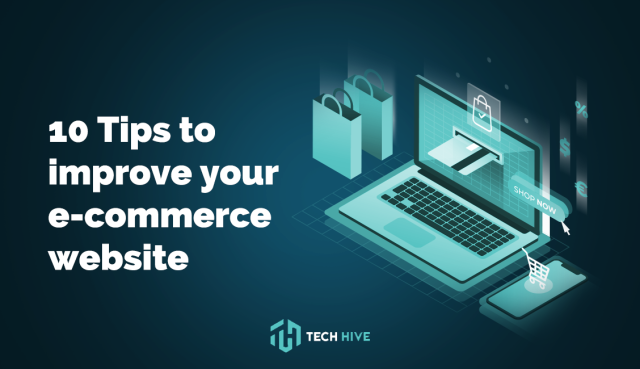
Ever since the emergence of Amazon, online shopping is a trend. Everywhere you look there’s a new e-commerce app, and while there are a lot of benefits to creating one, it can be hard to gain enough traffic nowadays.
So, I present to you: 10 tips to improve your e-commerce website!
#1: Have a landing page
The main purpose of the landing page is to encourage the user to download and install the app on their smartphone. It’s basically a one page website that describes the main features and functionality of your app.
There are three most common target action options:
Subscription – collecting a database of users interested in the app.
Bonus programs – customers are attracted with promo codes and discounts.
Download links – buttons with catchy phrases or custom QR codes.
Also, having a simple and clean UI will do wonders for your user’s comfort. The sleeker the UI, the more likely users will be attracted.
#2: Deep Linking
Deep links are a type of link that sends users directly to an app instead of a website or a store. Mobile statistics services allow you to segment app users according to their actions. You can create a segment of users who ordered a specific product at a specific time. Let’s suppose that you have a shoe store. Preferences of users who love shoes made of genuine leather, without a heel, and in a discreet color, suggest that they love comfort. The segment of such users should be offered other “comfortable” products from your assortment. Offer this segment a specific product or product category by setting up ads on landing pages.
This is where a deep link comes to the rescue – when a user clicks the ad, they are taken to a page in an eCommerce mobile app with an offer that matches their interest.
#3: Tracking
E-commerce Tracking is a feature of Google Analytics that tracks shopping activity on your website. You can use it to track and analyze transaction data, revenue, products you’ve sold, and more. It will give you specific insights that will help you figure out which of your products are in demand and which aren’t.
#4: Offer discounts
You have to give your users a reason to download your app, an effective strategy is to encourage users to make purchases only through the app, by offering exclusive discounts.
For example, make some discounts available only in the app. For the greatest results, promote your app special offers on every possible channel. This way, your app downloads will increase dramatically.
#5: Personalize user experience
Personalization is the tailoring of certain functionality to the user’s behavioral pattern. An app with personalization features suggests actions that the user could perform but would have looked for them for too long without a prompt. This should help the user to quickly make a purchase or solve another problem through the app. For this to succeed, it’s necessary to identify and analyse user patterns as well as track how they change.
#6: Feedback
If you involve all your stakeholders in your feedback loops, you’ll be able to get valuable inputs from them regarding your app’s features and functionalities.
Your team and users can help you innovate your app.
#7: Log-in and Check-out process
A complicated sign-up or check-out process is usually a turn-off to a lot of users that it gets abandoned half-way. If you give your user too much time to think then they will eventually find a reason to not spend their money. That isn’t something you want to happen. Use social sign-in as a quick way to create user accounts to your app.
#8: The Three Tap rule
If a user can’t find what they’re looking for after three clicks, it’s highly likely that they will get frustrated and leave. We don’t want that to happen.
You have to ensure that your application has a UI & UX design such that your users can get from the top category to the actual product they would like to buy in three taps. The common and effective method is to have the category > subcategory > product.
If you’re finding it hard to implement the three tap rule, you have to at least ensure that your search functionality is consistently providing accurate results quickly.
#9: Security
When you have an e-commerce app, you ask for details from your customers like bank account details, credit card info, address and so on. If your user’s personal and financial information is unprotected this will cause your app immediate failure and your reputation would never recover.
80% of the consequences of poor security can be eliminated by using those tactics:
1- Get trained on secure coding practices: Management should support and fund this effort, and it may require some back pressure — urging from the developers, QA and product management — to get them to buy in. There are training programs specifically for secure coding, ethical hacking classes so you can channel your inner attacker, conferences, mailing lists and an abundance of other resources to get your technical staff up to speed on security threats.
2- Use only stored procedures for database calls: This step will help prevent SQL injection attacks, which abuse database statements sent as SQL command strings instead of using parameterized procedures.
3- Sanitize user input: This step will go a long way toward stopping cross-site scripting (XSS) and cross-site request forgery (XSRF) attacks. Whereas SQL injection targets Web servers, XSS/XSRF targets clients by tainting the HTML that’s served to the browser.
4- Integrate source and dynamic application security testing into your development process: SAST and DAST solutions aren’t substitutes for secure coding practices, but they will help you catch what you might miss. Beyond the benefits of catching latent security vulnerabilities, these solutions integrate with your source control solution and can help train developers by giving detailed information about how vulnerability manifests itself. Application scanning solutions can also identify chronic defects so you can focus your training efforts.
5- Instrument granular and meaningful events and errors: One of the major reasons there are so many grey bubbles in the graphic on public disclosures is because organizations are unable to perform complete and timely forensics investigations. This is in part due to a lack of technology and process — no log management, SIEM solutions or not collecting the right telemetry — but many systems also produce generic or esoteric events.
#10: Consistency
Consistency in your app’s fonts, colors, design schemes is highly important. However, also focusing on the consistency in your image sizes, product descriptions, and prices is just as important. All the information mentioned in your app should be 100% accurate at all times.

